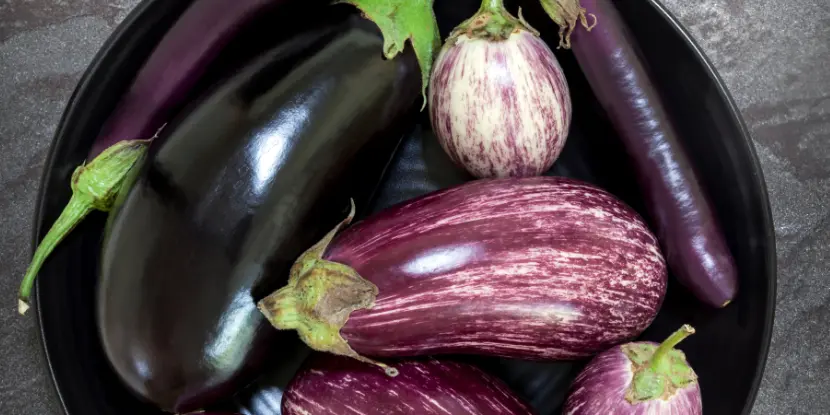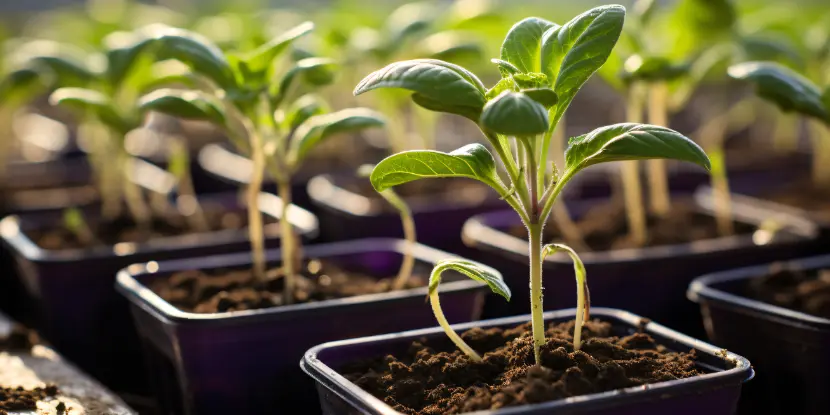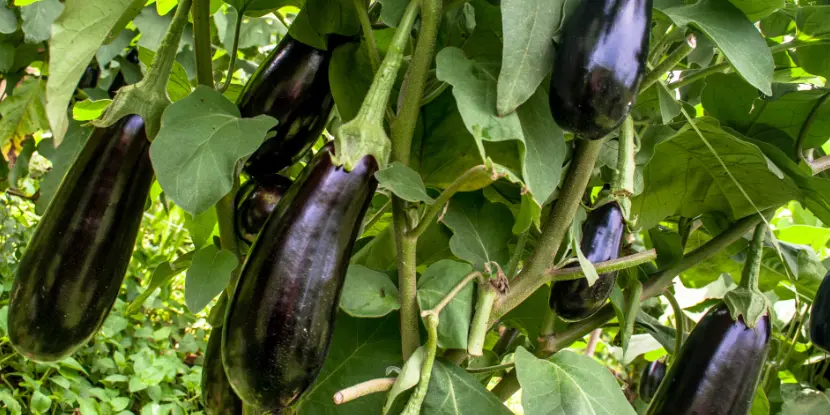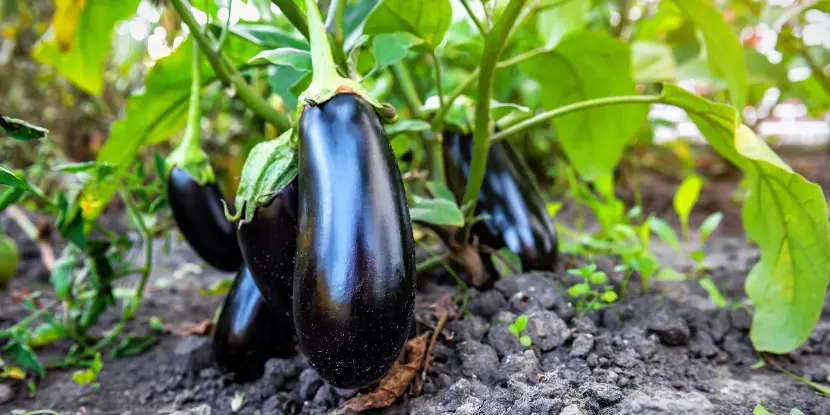The eggplant was first cultivated in Asia. However, most of its wild relatives are from Africa.
This oft-maligned tear-shaped vegetable is a staple in many international cuisines and the beloved Italian comfort dish eggplant Parmesan.
Cooked eggplant has a creamy texture and an uncanny ability to absorb flavors. This makes it the perfect canvas for layers of tomato sauce and melted cheese.
Eggplant’s melt-in-your-mouth quality also makes it a favorite among vegetarians, who use it as a hearty meat substitute and a frequent ingredient in stir-fries, sauces, dips, curries, and more.
Eggplant’s Journey to Your Table
From its (probable) birthplace in India, eggplant spread to other parts of the world via trade routes.
It wasn’t until the 16th century that eggplant made its way to Europe, where it was grown as an ornamental plant. In the late 18th and early 19th centuries, it gained popularity as a food crop in Italy and other parts of Europe.
Fast-forward to today. Eggplant is cultivated worldwide, with different varieties grown in various climates and regions, including — you guessed it — Southern California.

Different varieties of eggplant.
Benefits of Eggplants
- Eggplants are rich in vitamins C, K, B6, thiamine, and niacin.
- They’re low in calories and feature prominently in the Mediterranean diet, one of the world’s healthiest.
- Eggplants have anti-inflammatory properties and are high in antioxidants, making them beneficial for heart health.
- They contain nasunin, which protects brain cells from damage and improves memory.
- They’re a good fiber source, aiding digestion and promoting gut health.
- They’re also a good source of potassium, which helps regulate blood pressure and maintain heart health.
- Plus, they’re delicious!
Now, doesn’t that make you want to start growing eggplant in your own backyard? Immediately?
Growing the Perfect Eggplant
Eggplant thrives in warm climates with plenty of sunlight.
- When choosing the type of eggplant to grow, consider your region’s climate and soil conditions. Some popular varieties include Black Beauty, Rosa Bianca, and Japanese White Egg.
- Eggplants prefer well-drained, nutrient-rich soil with a pH level between 6.0 and 7.5. Before planting, add organic matter like compost or aged manure to the soil.
- Eggplants need at least 6-8 hours of sunlight daily.
- Eggplants are sensitive to cold and grow best in temperatures between 70°F and 85°F (21°C and 29°C). Wait until all danger of frost has passed before planting them outdoors.
Propagating Eggplant
Eggplant is primarily propagated through seeds.
- If you’re collecting seeds from a mature eggplant, choose a ripe fruit that has turned brown and wrinkled. Cut it open and scoop out the seeds.
- Rinse the seeds thoroughly to remove any pulp. Soak them in water for a few days to ferment and loosen any remaining flesh.
- Spread the seeds on a paper towel or clean cloth and allow them to dry completely. This can take several days to a week.
- Store the dried seeds in a cool, dark place in a labeled envelope or airtight container. Properly stored seeds will remain viable for several years.
Starting Eggplant from Seeds
- Starting Seeds Indoors: Sow eggplant seeds indoors 8-10 weeks before the last expected frost date. Use seed trays or small pots filled with a high-quality seed-starting mix.
- Temperature and Moisture: Keep the soil consistently moist and maintain a temperature of about 75-85°F (24-29°C). A heat mat can ensure the soil stays warm.
- Amending the Soil: Add a layer of compost or aged manure to the soil in your garden bed before transplanting.
- Transplanting Outdoors: When seedlings have 3-4 true leaves, and the risk of frost has passed, you can transplant them outdoors. Space plants about 2 feet apart.

Eggplant seedlings ready for transplanting.
Pollinating Eggplant
- Plant flowers and herbs that attract bees and other pollinators near your eggplant garden. Examples include lavender, marigold, and basil.
- If natural pollinators are scarce, you can hand-pollinate. Use a small brush or cotton swab to transfer pollen from the male flower (with long, skinny stalks and no bulge at the base) to the female flower (with a swollen base).
- Lightly shaking the plants in the morning can release pollen from the flowers and improve pollination rates.
- Inspect your plants for signs of successful pollination, such as fruit swelling behind the female flowers. If you notice flowers dropping without setting fruit, try hand-pollinating more often.
Caring for Eggplant
- Keep the soil moist but not waterlogged. Eggplants prefer a steady supply of water.
- Apply a layer of mulch around the base of plants to retain moisture and suppress weeds.
- Use a balanced fertilizer every 2-3 weeks during the growing season.
- Midway through the growing season, side-dress plants with compost or aged manure to provide additional nutrients.
- Pruning can promote better air circulation and prevent disease. Remove any damaged or diseased leaves or branches, as well as any suckers that may divert energy from the main stem.
- As eggplants grow taller, some varieties may need staking or support. Use cages, stakes, or trellises to keep plants upright and prevent them from breaking.
- Look for flea beetles, aphids, and tomato hornworms. These can be controlled with organic pesticides or natural methods like companion planting.

A cluster of eggplants growing like blazes.
Growing Eggplant in Containers
If you don’t have space for a traditional garden, you can still grow eggplants in containers on your balcony or patio.
- Select a container at least 12-14 inches deep and wide with drainage holes at the bottom.
- Choose compact or dwarf eggplant varieties, such as Fairy Tale, Bambino, or Patio Baby, that are well-suited for container gardening.
- Fill the container with a well-draining, high-quality potting mix rich in organic matter. Avoid using garden soil.
- Place the container in a sunny location where plants will receive at least 6-8 hours of direct sunlight daily.
- Keep the soil moist but not soggy. Container soil tends to dry faster than ground soil, so check the moisture level regularly.
- Feed the eggplants with a balanced liquid fertilizer every 2-3 weeks. You can also use slow-release granular fertilizers.
- If the eggplants grow tall and heavy with fruit, support them with stakes or small cages.

Deep purple eggplants ready for harvest.
Harvesting Eggplant
Eggplants are generally ready to harvest 65-80 days after transplanting.
- Harvest when the fruit is firm, shiny, and smooth.
- Use a sharp knife or pruner to cut the stem above the calyx (the green leafy part at the top of the fruit).
- Don’t allow eggplants to get too large; they can turn bitter and develop tough seeds.
- Store harvested eggplants in a cool, dry place or the refrigerator for up to a week. Avoid storing them near fruits that produce ethylene gas, such as apples and bananas.
Time to Eat!
Now, it’s time to enjoy the delicious fruits of your labor. You can prepare the versatile eggplant in endless ways!
- Grilled Eggplant Sandwich: Cut thick slices, brush with olive oil, and grill until tender. Serve on crusty bread with hummus, roasted red peppers, and fresh greens.
- Ratatouille: A classic French dish made with eggplant, tomatoes, zucchini, and bell peppers.
- Eggplant Parmesan: Layer grilled or breaded eggplant slices with marinara sauce, mozzarella cheese, and parmesan cheese. Bake until bubbly and golden brown.
- Baba Ganoush: A Middle Eastern dip made with roasted eggplant, tahini, lemon juice, and spices.
- Eggplant Fries: Cut eggplant into strips, dip in beaten eggs and breadcrumbs, and bake until crispy.
- Stuffed Eggplant: Halve an eggplant lengthwise, scoop out the flesh, and fill it with a mixture of cooked grains, vegetables, and seasonings. Bake until tender.

A tempting eggplant parmesan read to be served.
FAQs: Tips for Growing Eggplant
Q: When should I plant eggplant?
Plant eggplants after the last frost date when the soil has warmed up. Typically, this is in late spring or early summer.
Q: How do I know when to harvest eggplant?
Harvest eggplants when they’re shiny and firm, with a glossy skin. Use pruning shears to cut them from the plant, leaving a small portion of the stem attached.
Q: How can I maximize eggplant yield?
Apply a balanced fertilizer before planting, and side-dress with compost during the growing season. Mulching around the plants can retain moisture and suppress weeds, leading to a healthier crop.
Q: Can I grow eggplants from store-bought fruits?
Store-bought fruits are often hybrids, and the seeds may not produce true-to-type plants. Purchase your seeds from a reputable supplier, like a garden center.
Q: What are common pests affecting eggplants, and how can I manage them?
Common pests include flea beetles, aphids, spider mites, and tomato hornworms. Manage them with organic pesticides, introduce beneficial insects like ladybugs, or employ natural methods like companion planting with marigolds or basil to deter pests.
Q: How do I prevent eggplant diseases?
Preventive measures include:
- Practicing crop rotation.
- Providing adequate spacing for air circulation.
- Keeping the garden clean of debris.
- Avoiding overhead watering.
Choosing disease-resistant varieties can also mitigate common issues like verticillium wilt and bacterial wilt.
Q: Can I grow eggplants indoors?
Yes, provided they have sufficient light. Use a grow light to supplement natural sunlight and ensure the plants get at least 12-14 hours of light per day. Choose compact varieties suitable for container growing.
Q: How do I deal with poor eggplant flowering and fruit set?
Stressful conditions like extreme temperatures, inadequate watering, or lack of pollination can cause poor flowering and fruit set. Hand-pollinating flowers with a small brush can improve fruit set.
Q: Why are my eggplant leaves turning yellow?
Yellowing leaves may indicate overwatering, nutrient deficiencies, or pest infestations. Check the soil moisture, adjust watering practices, ensure balanced fertilization, and inspect plants for pest damage.
Q: Can I save seeds from my eggplants for future planting?
You can save seeds from non-hybrid eggplants. Allow the fruit to overripen on the plant, then cut it open and scoop out the seeds. Wash and dry the seeds thoroughly before storing them in a cool, dry place.

